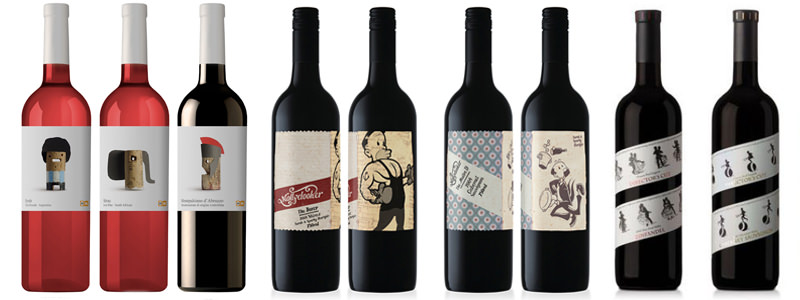Choosing a book by its cover — judging by outward appearance or “prettiness” — is simply what we do. But does it always make sense? Maybe not. But can it be effective? Well, our keen eye certainly says a lot about our preferences in flavor and in life. Can this method work with wine? Maybe so…
With the vast array of choices on the shelves these days, selecting the perfect bottle to suit our palate can be a bit overwhelming and quite a feat. From the kitchy and clever graphics jumping out of a letter-pressed label on one aisle, to the active animals bursting with color we see over our other shoulder, or even to the nostalgic and whimsical vacation images of beaches and sandals peeking out at us from the other corner, wine labels can be rather seductive or atrociously mundane.
If one isn’t able or willing to invest in developing a strong brand or connecting with consumers, with all the choices available on the market, winemakers really only have two avenues to quickly draw in first-time customers: price point and packaging. Certainly a label holds much more information than the winemaker’s name and graphical depiction, but the vast majority of wine buyers really possess little knowledge regarding a wine’s vintage, region, terroir, etc., nor do they really care to pay attention to such selective and enlightening refinement of information. Thus, marketing to both the wallet and the eye is most winemakers’ best bet.
The goal is to attract our attention, say a little something about the character of the contents within the bottle we see, as well as please our pocketbook. As both the marketing world and the world of wine have evolved, long gone are the utilitarian and “French” looking labels; instead we find ourselves facing labels that have hint of humor, a genre of “hipness,” and often a look of genuine sophistication. So, the question for you is, which sort of “look” do you prefer? If your mind’s eye says “yes,” most often, so will your palate. The label may describe your latest Pinot as medium-bodied, slightly fruity, with a smooth finish, but, is that why you bought it, or was it the “Pottery-Barn”-esque, picture-perfect letterpress label you knew would complement your centerpiece so well that drew you to the bottle?
It’s okay to admit it. I’ve been there too. The ultra enticing and seemingly hand-painted label, full of color and panache, has won over more than just a few times in my shopping basket.
I’ve also learned my lesson, though, as too much color and too little dollar also means too much headache and too little flavor.
After all, cheap wine is cheap wine.
If we are going to take the route of choosing a bottle beyond its prettiness, there are a few basic tidbits of information that can be helpful and somewhat useful in our selection process:
Grape – If you know what grapes you’ve liked in the past (Cabernet, Syrah, Sauvignon Blanc, Chardonnay, etc.), it’s safe to stick to those varieties.
Region – Warmer climates lend themselves to fruitier, less acidic wines, while cooler regions typically produce sharper flavors. Do you prefer a wine from Paso, where the nights are cool and the days are hot, or something from the heated hills of Australia?
Alcohol Content – The % by volume indicates how full-bodied your wine will be. Higher than 11% or 12% means a deep, rich and luscious wine, most often dry. Less alcohol content can be much sweeter, but still rather light in feel.
One more note to remember: if you recognize a winemaker has changed their label and rebranded of late, trying to appeal to a new customer base, you may want to question why. The best wines are those that are selling well despite a fancy-schmancy new design. We love them simply because they taste great, and for no other reason.
Thus, to answer the question, can we really judge a wine by its bottle? In most cases, I think so. I know I will certainly keep perusing the aisles for that eye-catching and in-the-moment Instagram worthy bottle.
After all, what have I got to lose? It’s still wine!
Having been a lover of fine food her whole life, Ashley Sara DeKam grew up in the gourmet foods industry and developed an intricate and creative palate, as well as a way in the kitchen. The kitchen is her “canvas,” of sorts. She has developed a very intricate and intimate relationship with food, pairing that with a passion for learning the science behind both food and wine. And, she simply loves to write, translating her passions into entertaining expressions and experiences for others.

